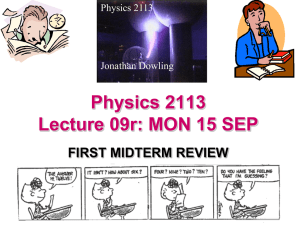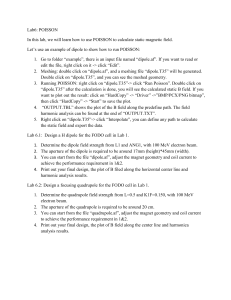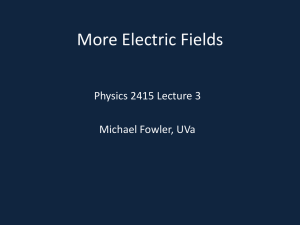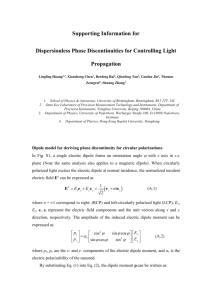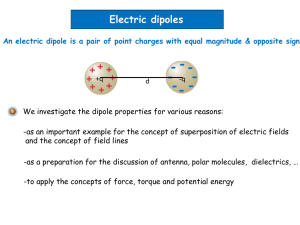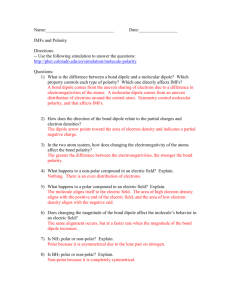PS01 Electric Dipole_sol
advertisement
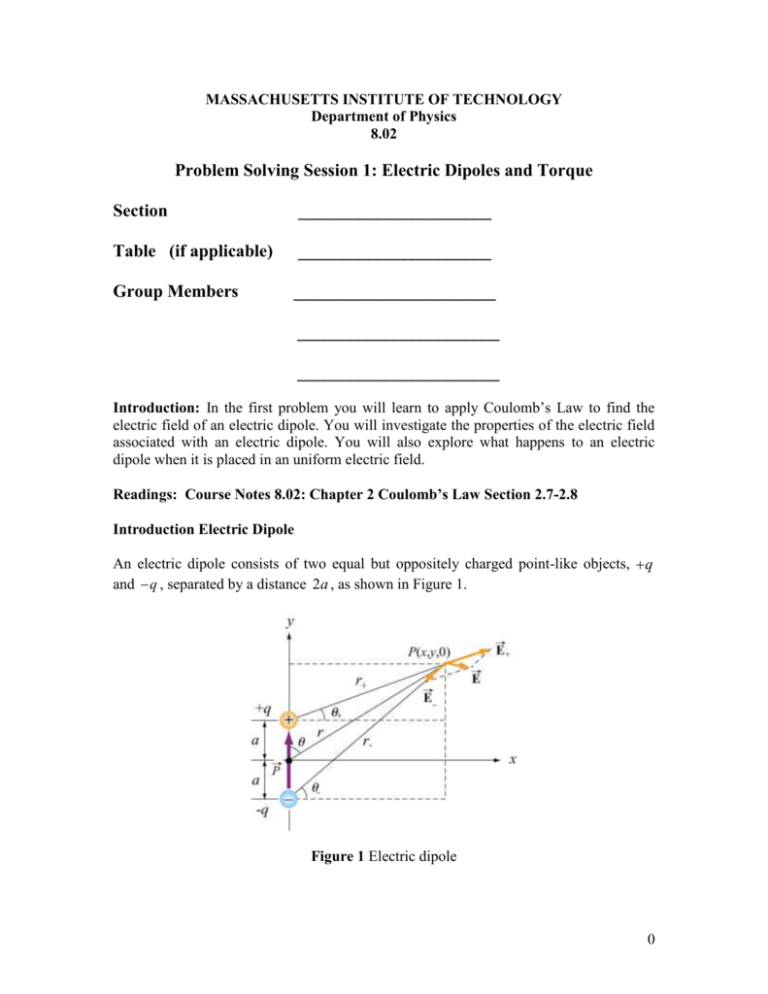
MASSACHUSETTS INSTITUTE OF TECHNOLOGY Department of Physics 8.02 Problem Solving Session 1: Electric Dipoles and Torque Section ______________________ Table (if applicable) ______________________ Group Members _______________________ _______________________ _______________________ Introduction: In the first problem you will learn to apply Coulomb’s Law to find the electric field of an electric dipole. You will investigate the properties of the electric field associated with an electric dipole. You will also explore what happens to an electric dipole when it is placed in an uniform electric field. Readings: Course Notes 8.02: Chapter 2 Coulomb’s Law Section 2.7-2.8 Introduction Electric Dipole An electric dipole consists of two equal but oppositely charged point-like objects, q and q , separated by a distance 2a , as shown in Figure 1. Figure 1 Electric dipole 0 The dipole moment vector p which points from q to q (in the y- direction) is given by p 2qa ˆj (1) The magnitude of the electric dipole is p 2qa , where q 0 . For an overall chargeneutral system having N charged objects, the electric dipole vector p is defined as r i N r p qi ri (2) i1 where ri is the position vector of the charged object with charge qi . Problem 1 Electric field of a Dipole Question 1: Consider the electric dipole moment shown in Figure 1. Find the x- and ycomponents of the electric field at a point with coordinates (x, y,0) , using r r q r q r E ke 3 r and E ke 3 r . r r Solution: From the figure we have that the vectors from the charged particles to the field point are r r x φ i ( y ma)φ j The respective distances from the positive and negatively charged objects to the field point at (x, y,0) are given by the expressions r (x 2 ( y ma)2 )1/ 2 The charges are q q and q q . Therefore the superposition of the two electric fields yields r r r q r q r E E E ke 3 r ke 3 r r r xφ i ( y a)φ j xφ i ( y a)φ j ke q 2 2 3/ 2 2 2 3/ 2 (x ( y a) ) (x ( y a) ) The x -component of the electric field strength at the point P is then 1 x x . Ex ke q x 2 ( y a)2 3/ 2 x 2 ( y a)2 3/ 2 Similarly, the y -component is given by ya ya E y ke q x 2 ( y a)2 3/ 2 x 2 ( y a)2 3/ 2 We can show that the electric field of the dipole in the limit where r a is Ex ke 3p r 3 sin cos Ey ke p r 3 (3cos 2 1) (3) where sin x / r and cos y / r . Question 2: By what power of distance does the strength of electric field fall off? How does this compare to a single point charge? Briefly explain a reason for the difference between these two cases. Solution: The electric field E due to a dipole decreases with r as 1/ r 3 , unlike the 1 / r 2 behavior for a point-like charged object. This is to be expected since the net charge of a dipole is zero and therefore must fall off more rapidly than 1 / r 2 at large distance. The exact electric field lines due to the oppositely charged objects are shown in the figure on the left in Figure 2. The electric field lines corresponding to the electric dipole given by Eq. (3) are shown in the figure on the right in Figure 2. Figure 2 Electric field lines for (a) a finite dipole and (b) a point dipole. 2 Problem 2 Electric Dipole in a Uniform Electric Field r i , with the dipole moment vector p Place an electric dipole in a uniform field E E φ making an angle with the x-axis. Question 1: What is a vector expression for the dipole moment p ? Give you answer in r the form p px φ i px φ j where you determine the components ( px , px ) . Solution: r From Figure 3, we see that the unit vector which points in the direction of p is cos φ i sin φ j . Thus, we have p 2qa(cos ˆi sin ˆj) (1) Question 2: Find a vector expression for the torque on the dipole. What point did you compute the torque about? Is your answer independent of that choice of point? Solution: As seen from Figure 3 above, since each point-like charged object experiences an r equal r rbut opposite force due to the field, the net force on the dipole is Fnet F F 0 . Even though the net force vanishes, the field exerts a torque a toque on the dipole that is independent of a choice of point. We select the midpoint O of the dipole about which to calculate the torque. r r r r r r F r F (acos φ i asin φ j) (F φ i) (acos φ i asin φ j) ( F φ i) φ asin F (k) φ asin F (k) (2) φ 2aF sin (k) where we have used F F F . 3 Question 3: What type of motion does the dipole undergo if it is released from its position and is free to move? Solution: The direction of the torque is kφ , or into the page. The effect of the torque is to rotate the dipole clockwise so that the dipole moment p becomes aligned with the electric field E . r r r Question 4: Show that p E . Solution: With F qE , the magnitude of the torque can be rewritten as 2a(qE ) sin (2aq) E sin pE sin r r r and the general expression for torque becomes p E . Summary Two equal but opposite point-like charged objects form an electric field that far from r the charged objects is an electric dipole. The electric dipole moment vector p points from the negative point-like charged object to the positive point-like charged object, and has a magnitude p 2aq r The torque acting on an electric dipole p placed in a uniform electric field E is r r r pE 4

